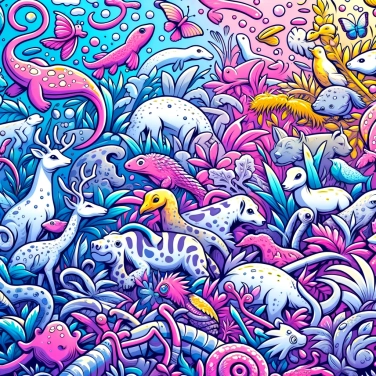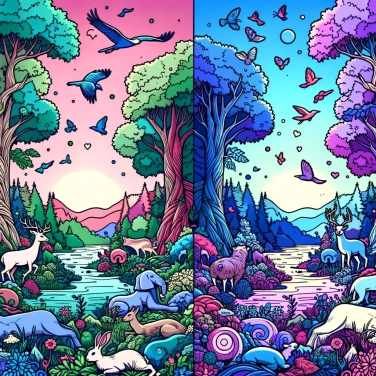Some animals change color to blend in with their environment in order to protect themselves from predators or to more easily catch their prey unnoticed.

Changing color to blend into the background is far from magical; it's downright clever biology. Most animals use special cells called chromatophores, filled with small sacs of colored pigments. By expanding or contracting these sacs, they instantly change their coloration. In chameleons, for example, layers of reflective cells, called iridophores, also play with light, creating incredibly precise colors. Other creatures, like certain squids, even have structures capable of altering their texture to mimic the appearance of their surroundings. All of this is triggered by their nervous or hormonal system, which quickly senses the environment to adapt color in real-time. Not rocket science, but remarkably effective for disappearing discreetly from a predator's view!
Camouflage is a true wildcard for remaining unnoticed by predators and for surprising prey. Many animals survive by avoiding becoming their neighbor's meal, and here, passing discreetly unnoticed is essential. For example, some insects perfectly mimic a leaf or a branch, thus avoiding being nibbled on. Conversely, predators also benefit from camouflage: lurking in the shadows, discreet until the last moment, stealthy hunters like the chameleon or the octopus catch their lunch more easily. In short, blending into the environment is often the best strategy for staying alive or filling one's stomach.
The animal adapts to the color, brightness, and texture of its surroundings in order not to be too noticeable. The type of vegetation, the color of the ground, or even the amount of light directly determine the shade it can take on. For example, in cold seasons, some animals turn white to match the snow. Conversely, in dark wooded environments, they opt for darker shades to blend into the scenery. Even temperature plays a role: excessively hot or cold conditions influence the speed and efficiency of this transformation. The time of day is similar: day and night can involve completely different shades to avoid attracting predators or to facilitate hunting.
Among the camouflage pros, it's hard not to mention the chameleon. Thanks to its special cells called chromatophores, it quickly changes color depending on its environment or mood. Another star of the genre, the mimic octopus adapts not only its color but also its posture and shape to blend in among corals, rocks, or even imitate other marine animals! Less flamboyant but just as formidable, the cuttlefish is an expert in patterns and shades to deceive predators or prey. And on land, quite discreetly, the tree frog subtly modifies its hues to become almost invisible on leaves and branches. Let's not forget the Arctic hare, whose fur turns white in winter to blend into the snow, returning to brown when the season warms up.
Adaptive camouflage is honestly super cool, but it does have its limits! First of all, color change usually takes a bit of time. When a threat arrives too quickly, the animal may not keep up, and then, well, it's a miss: we're far from being invisible. Another issue is the energy cost. Changing color regularly isn't free in terms of energy; it requires precious resources that the animal could use otherwise. Add to that factors like temperature and brightness, which can prevent some animals from perfectly blending into their environment. Finally, some predators use senses other than sight to hunt, like smell or vibrations—so even if the animal is well camouflaged by its color, it can still be easily detected.
Contrary to popular belief, the chameleon does not change color solely to hide, but also to regulate its mood, attract mates, and communicate with other chameleons!
Variable hares change their fur according to the seasons: white in winter to blend in with the snow and brown in summer to camouflage themselves in the lush green meadows.
Some species of mantis shrimp possess incredible vision capable of detecting ultraviolet light and polarized light, allowing them optimal visual camouflage against many predators.
Although animals widely use camouflage to avoid predators, some species also use this mechanism to approach their prey more discreetly, similar to certain hunting fish.
No, although camouflage is one of the main reasons, some animals also change color to communicate with their peers, attract a mate, intimidate rivals, or regulate their body temperature.
Animals have sensory organs such as eyes, which capture visual information from their environment. Their nervous systems interpret this information to adjust the color of their skin or fur, allowing them to blend better into their surroundings.
No, different species use various mechanisms. For example, chameleons change their colors using cells called chromatophores, while cephalopods use pigment cells known as iridophores, leucophores, and chromatophores to achieve a similar effect.
Sure! Here’s the translation: "Yes, certain factors limit camouflage, such as the time required to change color, the energy spent during this process, and the constraints related to the range of colors an animal can reproduce. Furthermore, rapid or unpredictable environmental changes make camouflage less effective."
Among the iconic animals that change color are chameleons, octopuses, cuttlefish, certain fish, frogs, and insects such as stick insects. Each uses specific mechanisms to adapt to its environment.

No one has answered this quiz yet, be the first!' :-)
Question 1/5